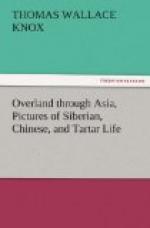When we returned from our drive, and were seated at dinner, the cook brought a quantity of “Tumen carpets” for sale. He used all his eloquence upon me, but in vain. These carpets were made by hand in the villages around Tumen, their material being goat’s hair. From their appearance I judged that a coarse cloth was “looped” full of thread, which was afterward cut to a plush surface. Some of the figures were quite pretty. These carpets can be found in nearly every peasant house in Western Siberia, where they are used as bed and table coverings, floor mats, and carriage robes.
From Tumen to Nijne Novgorod the post is in the hands of a company, and one can buy a ticket for any distance he chooses. We bought to Ekaterineburg, 306 versts, paying nine copecks a verst for each vehicle. At the stations it is only necessary to show the ticket, which will bring horses without delay. The company has a splendid monopoly, protected by an imperial order forbidding competition. The peasants would gladly take travelers at lower rates if the practice were permitted. The only thing they can do is to charter their horses to the company at about one-third the ticket prices. Alexander would make many friends among the people by curtailing the monopoly.
From the Tura the country became undulating as we approached the Urals, but we passed no rugged hills. A great deal of the road lay between double rows of birch trees, that serve for shade in summer and do much to prevent the drifting of snow in winter. Forests of fir appeared on the slopes, and were especially pleasing after the half-desolation of the steppe.
The villages had a larger and more substantial appearance, that indicated our approach to Europe. Long trains laden with freight from Perm, blocked the way and delayed us. A few collisions made our sleigh tremble, and in two instances turned it on its beam ends. We were ahead of the tea trains that left Irkutsk with the early snows, so that we passed few sledges going in our own direction. The second night found us so near Ekaterineburg that we halted a couple of hours for the double purpose of taking tea and losing time.
At the last station, about six in the morning, we were greeted with Christmas festivities. While we waited in the traveler’s room, two boys sung or chanted several minutes, and then begged for money. We gave them a few copecks, and their success brought two others, who were driven away by the smotretal. I was told that poor children have a privilege of begging in this manner on Christmas morning. There are many beggars in the towns and villages of the Urals, and in summer there is a fair supply of highwaymen. Several beggars surrounded our sleigh as we prepared to depart and seemed determined to make the most of the occasion.
The undulations of the road increased, and the fir woods became thicker as we approached Ekaterineburg, nestled on the bank of the Isset. Just outside the town we passed a large zavod, devoted to the manufacture of candles. An immense quantity of tallow from the Kirghese steppes undergoes conversion into stearine at this establishment, and the production supplies candles to all Siberia and part of European Russia.




